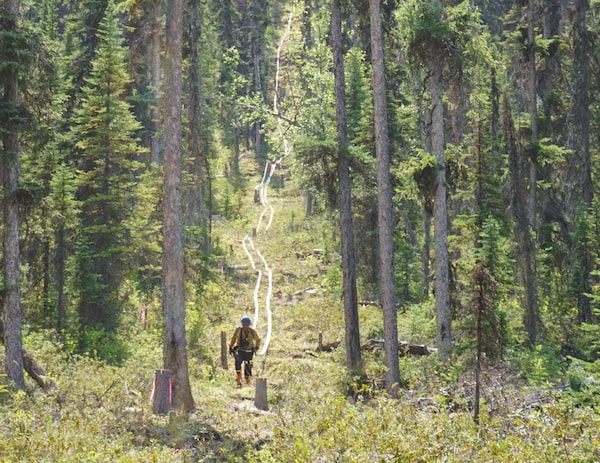
A Parks Canada fire crew member lays down hose on a containment line.
More than 60 staff employing 10 helicopters are fighting to keep B.C.'s Verdant Creek wildfire from crossing the Continental Divide into Alberta. It's a fierce confrontation in a fire season that may set record numbers. Jeff Weir is the manager of Parks Canada fire management. He spoke to Allan Maki about what it takes to be successful against the forces of nature
B.C. has lost 490,000 hectares of forest already this summer. Does this remind you of any previous years?
I've been on a management team since 1989 at Parks Canada and there is a year that parallels this year very closely, that being 2003, when we had a very dry southern portion of B.C. and Alberta. Many starts; very active season. This year is ahead of that [2003] so far. We're moving into the dry season in Western Canada [and] we're dryer than normal at this time. That said, one good regional-scale precipitation will make this a very active year, but without it will maybe be a record-breaking year. The season is not a surprise, actually. Environment Canada has done an excellent job forecasting the season. They indicated we would have a wetter-than-normal year in much of Western Canada to start with [for growing plenty of fire-spreading grass] then a dryer-than-normal summer and late summer. So far their prediction has been right on the money.
Do you get nervous at the start of every fire season, knowing one is coming but you don't know where?
The reason I don't is we do a lot of advanced planning for wildfire management. We develop fire-management strategies for parks and sites, which lay out the resource requirements. We ensure we have those resources on hand at the beginning of the year. Those plans identify what resources are required at different fire dangers – fire danger being different dryness levels of fuels. So we talk about being an extreme fire danger now. Those plans identify the resources we need to be ready to manage not only new starts, but new starts that might escape initial control. In Parks Canada, we maintain five incident-management teams. We have 16 highly trained professional fire crews that we can deploy. We also have relationships with partner agencies and develop mutual resource-sharing agreements, which are managed through the Canadian Interagency Forest Fire Centre. So we share in times of need and that's been an extremely effective way of managing fires. It means each agency doesn't have to man-up or resource-up to accommodate the worst-case scenario all the time. You man-up for the most-case scenario, and in times of need the other agencies that are in a position to help [they] help out.
How troublesome is the Verdant Creek fire?
It's mostly in Mount Assiniboine Provincial Park. The northern end of it, we're managing to ensure the protection of park values. That's well-resourced at this time. Sunshine Village [in Alberta] is being used as a staging area to facilitate that response to that north end to control the spread. Then the other part that is giving us concern is the fire has spread into Kootenay National Park and that fire has moved toward the Vermilion River so we're working on strategies and have plans in place to limit the potential of that fire to spread west.
What are those strategies?
Fire management looks at past weather, current weather and forecast weather. You look at the terrain and the attributes of the terrain to take control. We look at what fuel or vegetation the fire is burning in, and all of that change affects fire behaviour. When you examine all of those attributes together, you develop a plan not only looking at what's going to happen today, but the most important thing in fire management is to plan three to five days from now and plan probably even on a 10- to 15-day schedule. You need to be strategic on where you do your actions to reduce the potential growth of that fire and to make sure you're going to protect the highest values that might be at risk. Our worst case is things that affect human life. That's our first priority in fire management.
And when one strategy doesn't work?
What you need to do to be successful is anticipate where your plan is going to fail. So you build contingencies, and you build contingencies on many different scales, not only on the fire but maybe on a program basis. It's something you have to learn not to get frustrated with. You do your best job on a day-to-day basis. If you're unsuccessful you need to look at, "Okay, what do we have now?" and build the next strategy. That doesn't mean you don't care. You need to be able to reset and carry on. If you don't, you can't keep up to the fire … We want people to know Parks Canada is open for business. We are welcoming visitors and letting them know the Western parks are open to celebrate Canada 150, that there are many opportunities to enjoy these areas, and that there are some localized closures in place to ensure their safety. They can check this out on pc.gc.ca/fire-alerts and refer to alberta511.ca and DriveBC.ca for travel route planning.
This interview has been edited and condensed.